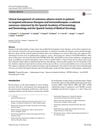Cutaneous Adverse Events of Targeted Anticancer Therapy: A Review of Common Clinical Manifestations and Management
December 2015
in “
DOAJ (DOAJ: Directory of Open Access Journals)
”
cutaneous adverse events EGFR inhibitors papulopustular eruption xerosis pruritus paronychia VEGFR inhibitors hand-foot skin reactions systemic antibiotics topical corticosteroids emollients lubricants skin reactions dry skin itching nail infection hand-foot syndrome antibiotics steroids moisturizers
TLDR Targeted anticancer therapies often cause skin issues, affecting treatment adherence and quality of life.
Targeted anticancer therapies, unlike traditional chemotherapies, often caused cutaneous adverse events, particularly in cosmetically sensitive areas. Common dermatologic toxicities associated with epidermal growth factor receptor (EGFR) inhibitors included papulopustular eruption, xerosis, pruritus, and paronychia, while vascular endothelial growth factor receptor (VEGFR) inhibitors typically led to hand-foot skin reactions. These side effects sometimes resulted in poor adherence, dose interruptions, and discontinuation of treatment, as well as psychosocial discomfort and reduced quality of life. Interestingly, the severity of these adverse events was positively correlated with treatment response. Management strategies were divided into prophylaxis and reactive treatment, with systemic antibiotics and topical corticosteroids potentially preventing or alleviating symptoms from EGFR inhibitors. Additionally, sun exposure prevention and the use of emollients and lubricants were recommended to manage hand-foot skin reactions.



